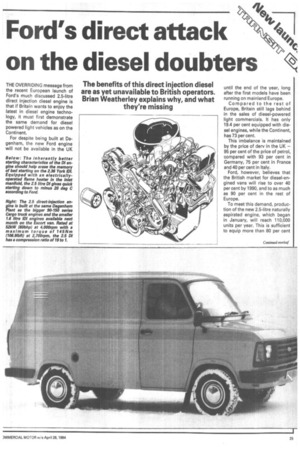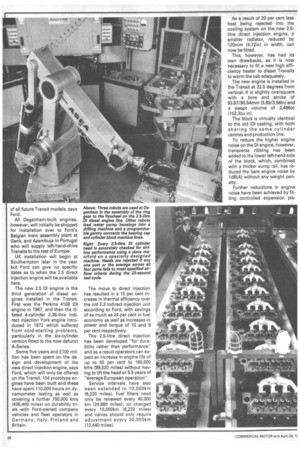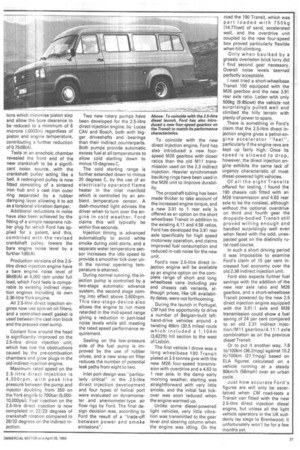Ford's direct attack 4 I
Page 27

Page 28

Page 29

If you've noticed an error in this article please click here to report it so we can fix it.
on the diesel doubters
The benefits of this direct injection diesel are as yet unavailable to British operators. Brian Weatherley explains why, and what they're missing
THE OVERRIDING message from the recent European launch of Ford's much discussed 2.5-litre direct injection diesel engine is that if Britain wants to enjoy the latest in diesel engine techno logy, it must first demonstrate the same demand for diesel powered light vehicles as on the Continent.
For despite being built at Dagenham, the new Ford engine will not be available in the UK until the end of the year, long after the first models have been running on mainland Europe.
Compared to the rest of Europe, Britain still lags behind in the sales of diesel-powered light commercials. It has only 19.4 per cent equipped with diesel engines, while the Continent, has 73 per cent.
This imbalance is maintained by the price of dery in the UK — 95 per cent of the price of petrol, compared with 93 per cent in Germany, 75 per cent in France and 40 per cent in Italy.
Ford, however, believes that the British market for diesel-engined vans will rise to over 40 per cent by 1990, and to as much as 90 per cent in the rest of Europe.
To meet this demand, production of the new 2.5-litre naturally aspirated engine, which began in January, will reach 110,000 units per year. This is sufficient to equip more than 80 per cent of all future Transit models, says Ford.
All Dagenham-built engines, however, will initially be shipped for installation over to Ford's Belgian main assembly plant at Genk, and Azambuja in Portugal who will supply left-hand-drive Transits to the rest of Europe.
UK installation will begin at Southampton later in the year but Ford can give no specific dates as to when the 2.5 direct injection engine will be available here.
The new 2.5 Dl engine is the third generation of diesel engines installed in the Transit. First was the Perkins 4108 IDI engine in 1967, and then the illfated 4-cylinder 2.36-litre indirect injection York engine introduced in 1972 which suffered from cold-starting problems, particularly in the six-cylinder version fitted to the now defunct A-Series.
Some five years and £100 million has been spent on the design and development of the new direct injection engine, says Ford, which will only be offered on the Transit. 154 prototype engines have been built and these have spent 110,000 hours on dynamometer testing as well as covering a further 700,000 kms (435,400 miles) on durability trials with Ford-owned company vehicles and fleet operators in Germany, Italy, Finland and Britain.
The move to direct injection has resulted in a 15 per cent increase in thermal efficiency over the old 2.3 indirect injection unit according to Ford, with savings of as much as 24 per cent in fuel economy as well as increases in power and torque of 10 and 8 per cent respectively.
The 2.5-litre direct injection has been developed "for durability rather than performance" and as a result operators can expect an increase in engine life of up to 50 per cent to 160,000 kms (99,520 miles) without having to lift the head or 5.5 years of "average European operation".
Service intervals have also been extended to 10,000km (6,220 miles). Fuel filters need only be renewed every 40,000 km (24,880 miles); oil changed every 10,000km (6,220 miles) arid valves should only require adjustment every 20,000km (12,440 miles). As a result of 20 per cent less heat being rejected into the cooling system on the new 2.5litre direct injection engine, a smaller radiator, reduced by 120mm (4.72in) in width, can now be fitted.
This, however, has had its own drawbacks, as it is now necessary to fit a new high efficiency heater to diesel Transits to warm the cab adequately.
The new engine is installed in the Transit at 22.5 degrees from vertical. It is slightly oversquare with a bore and stroke of 93.67/90.54mm (3.69/3.56in) and a swept volume of 2,496cc (152.3cu in).
The block is virtually identical to the old IDI casting, with both sharing the same cylinder centres and production line.
To reduce the higher engine noise on the DI engine, however, transverse ribbing has been added to the lower left-hand side of the block, which, combined with a thicker sump rail, has reduced the bare engine noise by 1dB(A) without any weight penalty.
Further reductions in engine noise have been achieved by fitting controlled expansion pis tons which minimise piston slap and allow the bore clearance to be reduced to a minimum of 8 microns (.0003in) regardless of piston and engine temperature, contributing a further reduction of 0.75dB(A).
Tests in an anechoic chamber revealed the front end of the new crankshaft to be a significant noise source, with the crankshaft pulley acting like a bell. A redesigned pulley is now fitted consisting of a sintered iron hub and a cast iron outer ring separated by a rubber damping layer allowing it to act as a torsional vibration damper.
Additional reductions in noise have also been achieved by the fitting of a simple neoprene rubber plug for which Ford has applied for a patent, and this, combined with the revised crankshaft pulley, lowers the bare engine noise level by a further ldB(A).
Production versions of the 2.5litre direct injection engine have a bare engine noise level of 98dB(A) at 4,000 rpm under full load, which Ford feels is comparable to existing indirect injection engines including its own 2.36-litre York engine.
All 2.5-litre direct injection engines now use spin-on oil filters, and a controlled-swell gasket is used between the cast iron block and the pressed steel sump.
Coolant flow around the head is significantly improved on the 2.5-litre direct injection unit, which has lost the obstructions caused by the pre-combustion chambers and glow plugs in the old indirect injection engine.
Maximum rated speed on the 2.5-litre direct injection is 4,000 rpm, with peak line pressure between the pump and injector doubling from 350 on the York engine to 700 bar (5,00010,000psi). Fuel injection on the 2.5-litre direct injection is now completed in 22/23 degrees of crankshaft rotation compared to 28/32 degrees on the indirect injection. Two new rotary pumps have been developed for the 2.5-litre direct injection engine, by Lucas CAV and Bosch, both with bigger driveshafts and bearings than their indirect counterparts. Both pumps provide automatic excess fuel at all temperatures to allow cold starting down to minus 10 degrees C.
The cold starting range is further extended down to minus 20 degrees C, by the use of an electrically operated flame heater in the inlet manifold which is controlled by an ambient temperature sensor. A dash-mounted light advises the driver when to turn over the engine in cold weather. Ford claims this will typically be within five seconds.
Injection timing is advanced automatically to avoid white smoke during cold starts, and a separate water temperature sensor increases the idle speed to provide a smoother tick-over until the normal operating temperature is attained.
During normal running, the injection pump is controlled by a two-stage automatic advance system, the second stage coming into effect above 3,600rpm. This two-stage device also allows the engine to run more retarded in the mid-speed range giving a reduction in part-load noise levels while still meeting the rated speed performance requirement.
Sealing on the low-pressure side of the fuel pump is improved by the use of rubber olives, and a new snap-on filter reduces the number of potential leak paths from eight to two.
Inlet port design was "particularly critical" in the 2.5-litre direct injection development and four types of helical port were evaluated on dynamometer and anemometer-type air flow rigs by Ford. The final design decision was, according to Ford the result of a "trade-off between power and smoke emissions". To coincide with the new direct injection engine, Ford has also introduced a new fourspeed M26 gearbox with closer ratios than the old M11 transmission used on the 2.3 indirect injection. Heavier synchromesh baulking rings have been used in the M26 unit to improve durability.
The propshaft tubing has been made thicker to take account of the increased engine torque, and a new 3.91 to 1 rear axle is offered as an option on the short wheelbase Transit in addition to the existing 4.11 and 4.56 ratios. Ford has developed the 3.91 rear axle specifically for high speed motorway operation, and claims improved fuel consumption and reduced in-cab noise for the new unit.
Ford's new 2.5-litre direct injection engine will be available as an engine option on the complete range of short and long wheelbase vans including psv and chassis cab variants, although prices, like UK availability dates, were not forthcoming.
During the launch in Portugal, CM had the opportunity to drive a number of Belgian-built lefthand-drive vehicles around a twisting 49km (30.5 miles) route which included a 1,104m (3,622ft) hill section to the west of Lisbon.
The first vehicle I drove was a long wheelbase 190 Transit plated at 3.5 tonnes gvw with the new M26 four-speed transmission with overdrive and a 4.63 to 1 rear axle. In the damp early morning weather, starting was straightforward with very little smoke, and the initial fast tickover was soon reduced when the engine warmed up.
Unlike some diesel-powered light vehicles, very little vibration was transmitted to the gear lever and steering column when the engine was idling. On the road the 190 Transit, which was part loaded with 750 kg (14.77cwt) of sand, accelerated well, and the overdrive unit coupled to the new four-speed box proved particularly flexible when hill-climbing.
Only when baulked by a grossly overladen brick lorry did I find second gear necessary. Overall noise levels seemed perfectly acceptable.
I next tried a short-wheelbase Transit 100 equipped with the M26 gearbox and the new 3.91 rear axle ratio. Laden with only 500kg (9:85cwt) the vehicle not surprisingly pulled well and climbed the hilly terrain with plenty of power to spare.
There is something in Ford's claim that the 2.5-litre direct injection engine gives a petrol-engine accelerator "feel", particularly if the engine revs are kept up fairly high. Once its speed is allowed to drop, however, the direct injection engine exhibits the same lack of urgency characteristic of most diesel-powered light vehicles.
Of all the eight Transits offered for testing, I found the 190 chassis cab fitted with an M26 transmission and 4.63 rear axle to be the noisiest, although without the optional overdrive on third and fourth gear the dropside-bodied Transit still proved willing enough and handled surprisingly well even when faced with the odd, unexpected goat, on the distinctly rural road course.
In such a short driving period it was impossible to examine Ford's claim of 15 per cent increased fuel economy over the old 2.36 indirect injection unit.
Ford also expects further fuel savings with the addition of the new rear axle ratio and M26 gearbox, and a short-wheelbase Transit powered by the new 2.5 direct injection engine equipped with the 3.91:1 axle and M26 transmission could show a fuel saving of 24 per cent compared to an old 2.31 indirect injection/M11 gearbox/4.11:1 axle combination as on the previous diesel Transit.
Or to put it another way, 7.8 lit/100km (36.2mpg) against 10.2 lit/100km (27.7mpg) based on ELA figures calculated on a vehicle running at a steady 90km/h (56mph) over an urban cycle.
Just how accurate Ford's figures are will only be ascertained when CM road-tests a Transit van fitted with the new 2.5-litre direct injection diesel engine, but unless all the light vehicle operators in the UK suddenly lay siege to Brentwood, it unfortunately won't be for a few months yet.




































































































